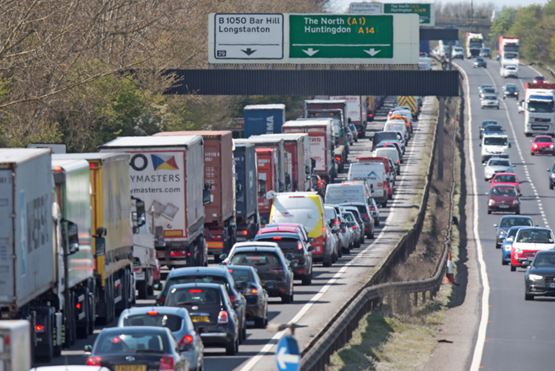 Read the peer reviews for this feature
Read the peer reviews for this feature
Campaign for Better Transport has long urged the Government to look at transport infrastructure holistically across the modes, on the basis that building more road capacity will merely stimulate more road traffic and therefore not solve road congestion.
We were pleased to manage Department for Transport-sponsored research which examines the economic benefits of using the railways to solve road congestion. Its results clearly illustrate the advantages of integrated cross-modal Government transport planning, instead of examining the modes separately. In essence, it highlights the socio-economic benefits of upgrading the rail network, as opposed to adding extra lanes to trunk roads on key strategic transport corridors with a parallel rail route.
So we are pleased with the official response from DfT, which said: “We agree with the Campaign for Better Transport that rail freight offers real benefits for the environment and helps keep bulky loads off of the road network, helping to ease congestion for other motorists. We look forward to using these findings to help inform our coming road and rail strategies, and are committed to working with the rail freight industry to support growth of the sector.”
Now we need these words to be translated into affordable rail freight access charges, in the review and funding for key capacity upgrades to the Strategic Rail Freight Network in the next Network Rail Control Period between 2019-24.
The research, carried out for Campaign for Better Transport by consultant MTRU, found that upgrading existing rail lines that run parallel to the motorway routes and are currently almost full would allow large numbers of lorry loads to be transferred to rail, thus reducing road congestion and improving productivity.
While this study considers four corridors separately, the creation of capacity in several corridors at once, plus a network of Strategic Rail Freight Interchanges (SRFIs) that are coming on stream, would also create additional opportunities to transfer traffic - particularly from the ports. The fact that the existing Strategic Rail Freight Interchange at Daventry removes 65 million to 70 million HGV miles a year, most of which would otherwise be on trunk roads, shows SRFIs’ potential to expand rail freight demand.
This research has the power to move the DfT transport planning debate forward. Thus we are urging the Government to use the findings of this research to feed into its future road (RIS2) and rail (HLOS) investment strategies that are now in preparation, and in particular to support continued investment in the Strategic Rail Freight Network. It shows that on certain strategic transport corridors it is possible to improve road conditions without needing to add more road capacity.
The DfT gave a target figure of removing 2,000 HGVs per day from each of the chosen freight corridors, which depending on the different levels of road congestion could equate to removing up to 8,000 cars per day.
The research therefore examined the potential of increasing rail freight capacity along four heavily congested freight routes: the A14 between Felixstowe and the Midlands; the A34 from Southampton to the Midlands; and the M6 and M62 motorways. The report analysed both the HGV and rail traffic on the transport corridors. The first three corridors meet the DfT criteria, with the M62 the only one that needs more research about cargo types data because of the shorter distances involved.
There is suppressed demand for rail freight services because of the lack of capacity on the rail network. Thus there is a level of current freight demand which could be transferred very quickly if capacity were to become available, meaning that the reduction of HGV flows could have a significant impact on road congestion.
However, even allowing for existing funded CP5 plans, moving 2,000 lorries a day to rail freight represents a doubling of current rail traffic from the examined ports, and this cannot be achieved without substantial additional investment in track and terminals. Smart paths and train lengthening, which have been taken into consideration, increases capacity.
HGV DATA
Three different methods were used for analysing the volumes of HGVs, to help validate the results which underpin the report.
- DfT count data (Annual Average Daily flows) was used at eight sites along the A34, at 12 sites along the A14, and at three sites on both the M6 and M62 - this shows year by year results, and type of and size of vehicle.
- Matrix data from a validated GB Freight model (GBFM) gave information on a combination of origins and destinations, likely routeing, and trip lengths. This uses known parameters such as journey length and concentration of trip ends (including national roadside data), and was important for the M6 and M62 analysis where origins and destinations are less clear than for the port traffic considered.
- Continuing Survey of Road Goods Transport (CSRGT) statistics showed trip lengths by size of HGVs and type of cargo nationally.
‘Big data’, such as mobile phone tracking, is not yet reliable for the HGV flows in question.
The national statistics showed that the largest HGVs (five-plus axles) make far more longer-distance trips than the smaller ones (see graph, page 41). This is not surprising, but the extent of the polarisation is noteworthy - a quarter of all their trips are over 300km (187 miles) and a half over 200km. Some of this long-haul traffic should be captive to rail if the rail network allows it.
In fact, these large HGVs (five- and six-axle artics) accounted for more than 50% of HGVs, which average 11% of all traffic on the sections of the network studied, whereas the average national distance travelled for large HGVs is 127km and the average for all HGVs is 85km.
The count data showed that the two A roads have up to 6,500 of the largest HGVs (five- and six-axle articulated lorries) on the corridors each day, between 10% and 17% of all traffic. The M6 has over 13,500 of the largest HGVs a day and the M62 has over 11,000, which represent 10%-12% of all traffic on the two motorway sections.
The corridor analysis shows that these national average figures must be used in combination with detailed corridor analysis, because on certain routes applying national statistics can be misleading.
The Government’s own 2014 policy statement on national networks claimed, by looking at the national figures only, that even doubling rail freight would only reduce road freight by 7%. However, the shift to rail of around 2,000 large HGVs a day on both the A14 and A34 corridors could reduce all sizes of HGV traffic by up to 17%.
DIFFERENT CARGO TYPES
A second analysis examined the trip length characteristics of different cargo types. This reveals the long-distance nature of unitised goods, in particular containers and palletised goods. The latter was perhaps less expected - two-thirds of this consignment type is on trips of over 150km. To put this in perspective, palletised goods form a third of all the distance travelled by consignments on GB vehicles.
This, of course, does not take into account size and weight or the number of pallets dropped at one or more locations, so it is not comparable to vehicle kilometres. One container, for example, may make up the entire payload of a large HGV.
M6 AND M62 ANALYSIS
While routes from ports provide an absolute concentration of origins and destinations (trip ends), and thus make the count-based analysis possible, corridors and specific points on the Strategic Road Network (SRN) need further analysis.
Hence the GB Freight Model was able to provide two contrasting points on the SRN, to undertake a supplementary analysis at key points on the network. These were: M6 (between junctions 12 and 13) to capture north/south movements; and the M62 (between junctions 21 and 22) to include shorter east/west movements.
However, a disaggregation by HGV type, identifying the largest artics, is not available at this level of the model output. In this sense, the analysis provides a conservative estimate of the concentration of trip ends, since many HGVs used for local deliveries will be captured as well as the largest used for longer-distance transport.
This effect is shown in the diagram (see opposite page). It can be seen that there are many more short-distance trips in the GBFM all HGV figure than the national figure for artics that have more than five axles.
Despite this effect, there is a very significant concentration of trip ends of all the HGVs at the sites on the SRN (origins and destinations), as shown in the two maps which follow (see above). In terms of potential impact, this concentration is used to assess the likelihood of transfer, as well as the distribution of trip length. The potential for reduction is applied to the DfT count data from the same sites, which does separate out the largest artics with five axles or more from other traffic.
The count data for the two sites is set out in the tables on the right.
Without additional data on cargo type and trip ends for artics alone, it is hard to produce a definitive transfer rate to rail. However, using the conservative distance data and the clear trip end concentrations, an estimate of the potential transfer was made and cross-checked with the rail freight operators. It was decided to use a transfer rate of 20% to see if this would achieve the threshold level of reduction. This resulted in the following reductions in the largest artics.
SUMMARY OF GBFM RESULTS
These high-level assessments show that in one instance - the M6 site - the criterion is likely to be met. On the M62 site, however, more data on cargo type is needed before ascertaining if the DfT HGV threshold will be met. Given the (as expected) shorter-length trips on the M62, it would nevertheless be worthwhile to investigate this corridor in more detail - in particular to isolate the trans-Pennine traffic and to allow for the high concentration of trip ends evident on the M62 map.
Data on cargo type would also be useful - for example, minerals are likely to be important in this corridor and would bring the heaviest rigid vehicles into play in terms of reducing HGV flows. For rail freight to compete, high volume will compensate for shorter trip lengths. Capacity issues on the parallel rail corridor (West Coast Main Line) are considered.
VEHICLES OR PASSENGER CAR UNITS
The congestion impact of the heaviest lorries is variable, depending on road conditions. The acceleration/deceleration/braking characteristics will mean much higher road space occupancy than the 2.9 passenger car units (pcus) often used. On the other hand, on an empty road, adding an extra car or articulated lorry will make no difference to the capacity of that road.
In this study, a range of three to four pcus has been used. Further work might be able to distinguish more disaggregated values by time of day. This study concentrates on the Strategic Road Network, a majority of which will have junctions designed to take larger HGVs. However, parts of the SRN - and the roads leading to the destinations of most of the HGV traffic - will not. In these circumstances the pcu value (for example, of turning articulated vehicles) can create pcu values extending to double figures.
RAIL ANALYSIS
The rail freight operators and Network Rail were consulted to establish the following:
- The likelihood and timescale for transferring the targeted traffic. What level of rail freight upgrades are needed on the rail network and what is planned by Network Rail.
- The additional network capacity required.
- How much capacity would be required in addition to existing NR plans already in the NR Freight Network Study.
- The Impact of more Strategic Rail Freight Interchanges and consolidation coming on stream. As more planned Strategic Rail Freight Interchanges become operational, there is further scope to transfer flows to rail.
- The increased capacity from smart paths (more efficient freight paths and also holding places for freight trains).
- Train lengthening and heavier trains are also taken into account.
SOUTHAMPTON CORRIDOR
Current rail mode share is about 35%, and there is an annual average daily flow (AADF) of 4,800 articulated HGVs with five axles or more immediately north of the freight terminal. Counts on the M3/A34 corridor stay high to at least as far as the M4.
In the longer term (say 2030), increasing the mode share to 50% - and after allowing for growth of 2% a year - would reduce articulated HGV flows by 2,200, and thus more than meet the initial criterion of removing 2,000 HGVs AADF. Interestingly, once allowance is made for the additional passenger car units value of the largest vehicles (between three and four) this would be far higher and represent a total traffic reduction of 12% to 16% (to Newbury). While the data is not available to absolutely determine the exact route taken, the nature of this corridor suggests that most of this HGV traffic will continue at least as far as the M4.
The recent Network Rail Freight Network Study shows short and longer-term improvements potential to accommodate the planned (but as yet unfunded) upgrades on the rail network.
Rail freight could be increased by 50% or 60% on both the A14 and A34 corridors within the next five to seven years, based on a combination of current funded CP5 Network Rail projects and the (as yet) unfunded Network Rail Freight Network Study CP5 proposals. Further network upgrades to meet the full DfT benchmark of transferring 2,000 HGVs daily would be required beyond 2024, which would also allow the rail freight operators time to further develop the rail market to meet the DfT benchmark.
RAIL CAPACITY/POTENTIAL TRANSFER
As well as the Network Rail summary of proposed capacity increases, rail freight operating companies were contacted for an additional insight into capacity and market shares. The results have been combined and anonymised to protect commercial sensitivities.
The report covers all four corridors in detail, and this article continues to show the Southampton example. The number of HGV equivalents removed by existing length trains has been calculated using mode share and count data for the two ports - it is about 70 for Felixstowe and 80 for Southampton. For the purposes of the report, an average of 75 has been used.
There is now broadly an hourly freight path each way throughout the Southampton-West Midlands route (at about 640m length trains). For all destinations, there are some 20 intermodal trains per day from Southampton Maritime and Western Docks (lengths in the range of 550m-600m). There are also some six or seven specialised non-containerised trains per day via Eastern Docks (up to 680m long).
The intermodal paths are due to rise to two per hour when the Oxford area capacity work is complete in 2019-20. The Southampton Train Lengthening works will provide for 700m-775m intermodal train running. Thus, on the cautious assumption of an extra 100m productive length per current intermodal train, the works effectively create three to four additional trains per day’s worth of intermodal capacity on current paths, twice that once the new paths are available.
It is not possible to predict exactly how many HGV equivalents this could take, but it is clearly in the right scale - the equivalent of around 30 (new paths plus extra length) extra train paths (2,250 HGV equivalents) per day. Lengthening will also reduce costs, encouraging mode transfer.
However, the operators point out that there are other capacity issues relating to terminals and distribution centres, if these paths are used. The planning framework for SRFIs has been put in place and several are proceeding, but sufficient are needed to ensure terminal capacity will be available for the level of expansion identified in this report, and in other regional and national freight strategies.
The research showed that upgrading three out of the four chosen strategic rail corridors parallel to the Strategic Road Network could significantly reduce HGV volumes on the A14, A34 and M6 corridors. It also revealed that more research is needed to ascertain cargo types on the M62, which almost meets the DfT threshold.
This research confirms what we have long argued - that integrated rail and road planning into a cross-modal approach is the best way to reduce road congestion, collisions and pollution. Freight on Rail will calculate the significant improvements to air quality, CO2 emissions and safety benefits of modal shift as a separate but related exercise, to illustrate the fuller socio-economic benefits of rail freight.

The Freight on Rail research provides interesting reading, and a nice counterpoint to the doom-laden soundbiters citing significant falls in rail freight traffic. Clearly, if you’re in the market for buying, selling, moving or burning coal for a living, then the Government’s selfish desire to reduce emissions and save the planet is a blow - notwithstanding the years of advance notice by Government that this was on the cards. Yet beyond the coal hole, prospects for construction and intermodal look much more encouraging.
Few would argue with FoR’s view that integrated rail and road planning into a cross-modal approach is the best way to reduce road congestion, collisions and pollution. Even the DfT, which since the departure of Tim Welburn and Chris Wilson has appeared to struggle with rail freight (see last year’s oxymoronic Rail Freight Strategy), is uncharacteristically positive towards the findings.
So why are we not yet basking in this cross-modal nirvana?
There are a multitude of reasons for this, and sadly many are the same hardy perennials that office-chair observers such as myself have been banging on about for years.
Beyond the disappearance of coal, the other elephants sulking in the other corners of the room are the cost of running / accessing the rail network, the time taken to plug in new railheads, the availability of decent paths, and the prices charged for the rail services themselves. No surprise that the end customers aren’t always overly impressed.
In terms of infrastructure, one of the biggest obstacles is the cost of new connections, meaning that only the largest Strategic Rail Freight Interchanges stand any realistic chance of affording it - assuming, of course, the planning system doesn’t continue to grind down the aspirations of developers to provide the very facilities that Government says it wants to see.
MTRU is right that upgrading existing rail lines parallel to congested motorway routes could allow large numbers of lorry loads to be transferred to rail, thus reducing road congestion and improving productivity - but not if there’s nowhere to load or unload the trains at each end, or if the costs of the upgrades then outweigh the benefits.
Turning to the train operators, fuel and/or infrastructure access charges account for over a third of the cost base. And with track access already down to a marginal cost basis, there’s little that Government policy could do with this to make it any cheaper without having to further compensate Network Rail in consequence.
For intermodal, an equally large chunk of the cost relates to lifting containers on and off the trains at each end, as well as the trucks needed at one or both ends to collect and deliver the containers. Despite the greater apparent efficiency of moving a trainload of containers between railheads, the total door-to-door price may then end up being not much different from straight road haulage. And road haulage isn’t resting on its laurels, with longer lorries, double-deck trailers, dual-fuel tractor units, self-driving or platooning vehicles all either in use or being tested, so don’t expect the level playing field to arrive or to then remain level for long.
Indeed, at an industry meeting a couple of years ago, one of the supermarkets implored the rail freight operators to achieve a major drop in prices in order to make intermodal irresistible - not 5% or 10%, but more like 20-30%. Easy to say, and who could argue with the sentiment, but I do have sympathy for operators trying to reconcile this request against large immovable chunks of cost on fuel and access, along with lifts and shifts at each end.
So what’s to be done to deliver the promise hinted at in the FoR research?
Fuel is an area that Government might want to dwell on, particularly given the incentives handed out to encourage gas-fired power stations, solar panels, scrapping old cars (and building factories for new ones), buying of first homes, winter warming of old age pensioners, and indeed moving freight by rail.
Given the relatively modest amount of fuel used by rail freight compared with other parts of the economy, and given the findings of the FoR research, it wouldn’t be too much of a stretch for Government to reduce (or remove) duty on fuel for locomotives and rail terminals (let’s call it Green Diesel and ignore the oxymoron), to reflect the wider environmental benefits of rail use. I’d argue that this would be a lot easier to administer for all concerned than the byzantine and increasingly rare Mode Shift Revenue Support scheme.
In addition, for as long as we remain in the EU there is also the Directive on Combined Transport (Eurocrat for intermodal), to reduce or remove the costs of moving containers by road to and from railheads, and for moving lorries by rail.
Since 1992 this has been taken up by most other Member States. In the review of the Directive which we carried out last year for the Commission, it was somewhat depressing to learn how far countries such as Austria and Germany had embraced the Directive compared with others - including the UK (spoiler alert), which confirmed that while implementation of the Directive was obligatory and that all the articles had been implemented, Article 6.1 (support for road vehicles carried by rail) could only be implemented once it was possible to carry taxed goods vehicles (tractor units) by rail in the UK. Oh, and Article 6.2 as well (exempting trucks moving containers to and from railheads from road vehicle taxes), as that couldn’t be implemented in a cost-effective way.
In an ideal world there would be: lower fuel charges for traction and/or a scrappage scheme to trade in everything pre-Class 60 and replace it with anything Class 88 or similar; little or no road taxes for trucks carrying containers to and from railheads; decent paths for freight with less recessing on route; W12 gauge to all corners of the UK; more cost-effective ways to plug new railheads into the network; and a planning system co-ordinated from national to local level to help these new railheads secure consent. The step-change in traffic which such a cunning plan could achieve would then provide the vital evidence base needed to underpin the business case for delivering new capacity when and where it’s needed, as part of a joined-up, cross-modal approach. Oink oink, flap flap, I hear you say. Quite.
But pending the arrival of strong and stable (along with sane and sustainable) Government policies towards the railways, the industry will (as ever) have to make the best of it. The emphasis will be on a small number of can-do individuals able to make bulk and intermodal trains as long or heavy as possible, make Royal Mail-type rail services as fast and mainstream as possible, make working practices as efficient as they are safe, and deliver new connections and gauge upgrades in a timely and cost-effective manner, alongside a steely determination to spend up to a quarter of a century securing consent for new interchanges and/or rail routes.
In other words, achieve little miracles every day that may often seem impossible to lesser mortals. The rest of us are very grateful that you do. In the meantime, those wishing to see FoR’s research findings made real should manage expectations accordingly, or work on developing porcine aviation instead.

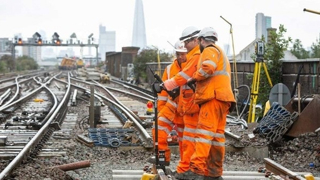
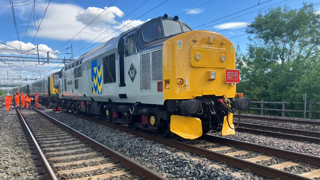

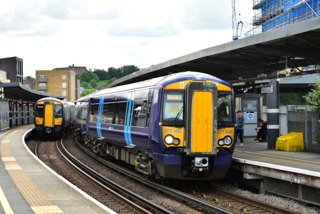
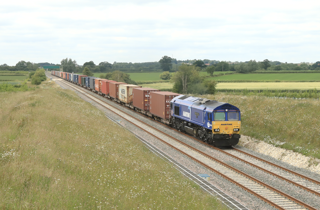







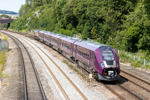


Login to comment
Comments
No comments have been made yet.